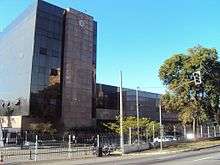Sport Club Corinthians Paulista
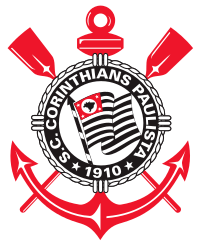 | ||||
| Full name | Sport Club Corinthians Paulista | |||
|---|---|---|---|---|
| Nickname(s) |
Timão (Great Team) Time do Povo (The People's Club) Todo Poderoso (Almighty) Coringão | |||
| Founded | September 1, 1910 | |||
| Ground | Arena Corinthians | |||
| Capacity | 49,205 | |||
| President | Andrés Sánchez | |||
| Head coach | Jair Ventura | |||
| League |
Campeonato Brasileiro Série A Campeonato Paulista | |||
| 2017 2018 |
Série A, 1st Paulistão, 1st | |||
| Website | Club website | |||
|
| ||||
Sport Club Corinthians Paulista is a Brazilian multi-sport club based in São Paulo, São Paulo. Although they compete in a number of different sports, Corinthians is mostly known for its professional association football team.
The football team currently plays in the Campeonato Brasileiro Série A,[nb 1] the top tier of the Brazilian football, as well as in the Campeonato Paulista Série A1,[nb 2] the first division of the traditional in-state competition.
Founded in 1910 by five railway workers, Corinthians was inspired by the London-based club Corinthian Football Club. Since 1910, Corinthians has become one of the most successful Brazilian clubs, having won the national title seven times, in addition to three Copa do Brasil trophies. Corinthians has a record 29 state championships. In 2000 the club won the inaugural FIFA Club World Cup as the host nation's representative, repeating the feat in 2012 after winning the Copa Libertadores de América for the first time.
The club was listed by Forbes as the most valuable football club in the Americas, worth $576.9 million.[1] The club is one of the most widely supported teams in the world and the 2nd in Brazil, with over 30 million fans.[2]
Since 2014, Corinthians plays its home matches at the Arena Corinthians, one of the venues in the 2014 FIFA World Cup, having hosted 6 matches during the tournament, including the opening match on 12 June 2014.
The club's home kit traditionally features white shirts and black shorts, accompanied by white socks, since 1920. Their traditional crest was introduced in 1939, by modernist painter Francisco Rebolo featuring the São Paulo state flag in a shield, two oars and an anchor (representing the club's early success in nautical sports). They hold many long-standing rivalries, most notably against Palmeiras, São Paulo and Santos .
History
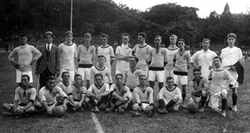
In 1910 the football in Brazil was an elitist sport. The top clubs were formed by people who were part of the upper classes. Among them were Club Athletico Paulistano, São Paulo Athletic Club,[3] & Associação Atlética das Palmeiras.[4] Lower-class society excluded from larger clubs founded their own minnow clubs and only played "floodplain" football.
Bucking the trend, a group of five workers of the São Paulo Railway, more precisely Joaquim Ambrose and Anthony Pereira (wall painters), Rafael Perrone (shoemaker), Anselmo Correia (driver) and Carlos Silva (general laborer), residents of the neighborhood of Bom Retiro. It was August 31, 1910 when these workers were watching a match featuring a London-based club touring Brazil, Corinthian F.C..[5] After the match, while the group returned home, The men spoke of partnerships, business ideas, and general dreams of grandeur. In the mind of each one surfaced a great idea: the foundation of a club, after several exchanges in a lively argument, a common ground led those athletes the same dream. The arguments led to the conclusion that they would meet the next day to make a dream into reality.
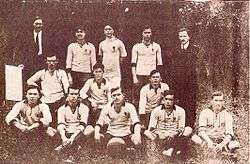
September 1, 1910. In anticipation of heavy rains, the group agreed to meet after sundown in public sight. That night at 8:30pm, on Rua José Paulino ("Rua dos Imigrantes" (Immigrants Street), underneath the glow of an oil lamp the five workers reunited alongside their guest and neighbors from Bom Retiro. That night the club was founded, alongside its board of directors, who elected Miguel Battaglia as the first Club President.[5]
Corinthians played their first match on September 10, 1910, away against União da Lapa, a respected amateur club in São Paulo; and despite being defeated by 1–0, this match would mark the beginning of a successful era as an amateur club.
On September 14, Luis Fabi scored Corinthians' first goal against Estrela Polar, another amateur club in the city, and Corinthians won their first game 2–0.
With good results and an increasing number of supporters, Corinthians joined the Liga Paulista, after winning two qualifying games, and played in the São Paulo State Championship for the first time, in 1913. Just one year after joining the league, Corinthians was crowned champion for the first time (in 1914), and were again two years later. There were many fly-by-night teams popping up in São Paulo at the time, and during the first practice held by Corinthians a banner was placed by the side of the field stating "This One Will Last".
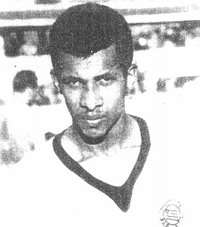
The year of 1922, the Centennial of Brazilian Independence, marks the start of Corinthians hegemony in the São Paulo State Championship. As football was almost exclusively played at Rio de Janeiro and São Paulo by that time, the two state champions were considered to be the two top clubs in Brazil. After defeating the Rio de Janeiro State Championship champion of that year, América, Corinthians joined the company of the great teams in Brazil.
The same year also marked the first of three State Championships in a row, something that happened again in 1928–30 and 1937–39.
Corinthians seemed destined to win State Championships in threes; after six years without being a champions, they came won three more from 1937 the 1939. The 1940s were a more difficult time; and the club would win a championship in 1941 and would only win their next in 1951.
At the beginning of the 1950s Corinthians made history in the São Paulo Championship. In 1951, the team composed of Carbone, Cláudio, Luisinho, Baltasar and Mário scored 103 goals in thirty matches of the São Paulo Championship, registering an average of 3.43 per game. Carbone was the top goalscorer of the competition with 30 goals. The club would also win the São Paulo Championships of 1952 and 1954. In this same decade, Corinthians were champions three times of the Rio-São Paulo Championship (1950, 1953 and 1954), the tournament that was becoming most important in the country with the increased participation of the greatest clubs from the two most important footballing states in the country.
In 1953, in a championship in Venezuela, Corinthians won the Small Cup of the World, a championship that many consider as a precursor of the Worldwide Championship of Clubs. On the occasion, Corinthians, substituting for Vasco da Gama, went to Caracas, the Venezuelan capital and recorded six consecutive victories against Roma (1–0 and 3–1), Barcelona (3–2 and 1–0) and Selection of Caracas (2–1 and 2–0). The club would also win the Cup of the Centenary of São Paulo, in the same year (1954).

After the triumphs in the São Paulo Championship and the Rio-São Paulo of 1954, Corinthians had a lengthy title drought. The breakthrough finally came when they won the São Paulo state championship in 1977, breaking a string of 23 years without a major title.
Under the leadership of Sócrates, Wladimir and Casagrande, Corinthians were the first Brazilian club in which players decided about concentração, a common Brazilian practice where the football players were locked up in a hotel days before a game, and discussed politics. (In the early 1980s, military dictatorship, after two decades, ended in Brazil). In 1982, before the election of government of São Paulo State, the team wore a kit with the words: DIA 15 VOTE (Vote on 15th),[6] trying to motivate the biggest number of fans to vote.
In 1990, Corinthians won their first Campeonato Brasileiro Série A, beating their rivals, São Paulo in the final at the opponents' own stadium, Estádio do Morumbi.[7] In the following year, Corinthians beat Flamengo and won the Supercopa do Brasil.[8] In the 1995, the club won the Copa do Brasil for the first time, beating Grêmio in the final at the Estádio Olímpico Monumental in Porto Alegre.[9] In the same decade, the club won the state championship in 1995, 1997 and 1999,[10] and won the national championship again in 1998 and in 1999.[11]
In 2000, Corinthians won the first edition of the FIFA Club World Cup, beating Vasco in the final played at the Estádio do Maracanã. To reach the final, Corinthians finished ahead of Real Madrid of Spain, Al-Nasr of Saudi Arabia and Raja Casablanca of Morocco.[12] In the same decade, the club won the state championship in 2001 and in 2003[10] and the Copa do Brasil in 2002, beating Brasiliense in the final.[13]
Between 1990 and 2005, the club also won the Ramón de Carranza Trophy in 1996, the Rio-São Paulo Tournament in 2002, the São Paulo Youth Cup in 1995, 1999, 2004, and 2005, and the Dallas Cup in 1999 and 2000.
The club's situation in early 2004 was among the most difficult in their history. Bad administration, lack of money and terrible campaigns both in the 2003 Brazilian Championship and in the 2004 São Paulo State Championship caused their millions of supporters to worry. Fortunately, some young players and a new manager Tite helped the team to improve from their terrible start. At the end of the championship, Corinthians finished in 5th place and gained entry to the Copa Sudamericana (a minor continental championship).
This situation was one of the factors which enabled Corinthians' president, Alberto Dualib, to convince the club's advisors to sign a controversial deal with an international fund of investors called Media Sports Investment. The deal granted the company a large degree of control over the club for 10 years in exchange for large financial investments in return. This has brought many quality players to the team, such as Carlos Tevez, Roger, Javier Mascherano and Carlos Alberto.
Despite the MSI investments, Corinthians experienced a slow start in the 2005 state championship, but managed to improve as it progressed, eventually managing to finish second. Their start to the Brazilian championship during 2005 was difficult, too, but after Daniel Passarella's dismissal (due to an unexpected 5–1 loss to Corinthians' rivals, São Paulo), the club finished the championship round well, and were eventually crowned Brazilian Champions for the fourth time, after a controversial annulment of eleven games due to a betting scandal.
The relationship between Corinthians' managers and the MSI president, Kia Joorabchian was not good, and after being eliminated in the Copa Libertadores, the club experienced a crisis which was responsible for the bad performances for the rest of 2006. Eventually, the partnership came to an end.[14]
On December 2, 2007, following a 1–1 draw away to Grêmio, Corinthians were relegated to the second division.

Corinthians, who won promotion to the top division of Brazilian football for 2009 by winning the Serie B tournament, signed with three-time FIFA Player of the Year Ronaldo.[15][16] In 2009, led by Ronaldo, Corinthians won their 26th Campeonato Paulista and their third Copa do Brasil. Confirming the club's good moment, Corinthians finished the Campeonato Brasileiro 2010 in 3rd place, granting their place on the subsequent Copa Libertadores. After being eliminated from the South American tournament by the relatively less traditional Deportes Tolima, though, Corinthians saw Ronaldo retire from football. To replace him, the club signed with other 2006 national squad veteran Adriano.[17] In 2011, Corinthians won their fifth national title.
On July 4, after reaching the final of the 2012 Copa Libertadores undefeated, Corinthians won its first title after a two-match final against 6-time champions Boca Juniors by drawing 1–1 in Argentina and accomplishing an inaugural victory at the Estádio do Pacaembu in São Paulo winning 2–0, becoming the ninth Brazilian side to win the Copa Libertadores.[18][19] After this historical title, Corinthians is considered the most valuable club in Brazil.[20] The club won the 2012 FIFA Club World Cup for the second time after defeating English club Chelsea 1–0 on December 16, 2012.[21][22][23]
Colors and badge
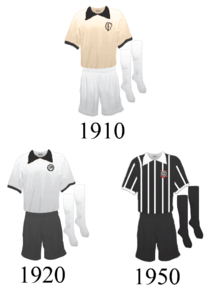
Even though the club has been recognized by the colors black and white for most of their history, the first Corinthians' kit originally consisted of cream shirts and black shorts. Back then, the choice of colors proved wrong, because when the shirts were washed, the cream color would gradually fade white, representing a cost a recently created club could not afford. Thus, early after the foundation, the official shirt colors were changed to white. In 1954 the traditional black with thin white stripes uniform was introduced, and became the alternative uniform since then.
The Corinthians' shirt had no badge or crest until 1913, when the club joined the Liga Paulista, that mandated that every club in the competition should have one in their uniforms. A simple composition of the letters C (Corinthians) and P (Paulista) was hastily created and laced in the players uniforms for the upcoming matches, thus being considered the club's first de facto badge.[24]
Unlike the kit, the badge went through several changes over the years. In 1914, lithographer Hermogenes Barbuy, brother of then-player Amilcar Barbuy designed the club's first official badge, which premiered at a friendly against Torino (Italy), in São Paulo.[25] In 1919, the round shield with the São Paulo state flag was introduced, and modified in 1939 by modernist painter Francisco Rebolo, a former reserve player of the club in the 1920s, to include a string, an anchor and two oars, representing the early success the club achieved in nautical sports. Thereafter, the badge passed through small changes over time, specifically in the flag and in the frame.[24]
In 1990, a yellow star was added above the badge to celebrate Corinthians' first national title. The same would occur when achieving the national titles in 1998, 1999 and 2005, and a larger star was introduced in 2000 after winning the inaugural FIFA Club World Cup. The stars remained as part of the badge until 2011, when the board decided the badge would not present any stars in the future.
| The Evolution of the Crest of Sport Club Corinthians Paulista | ||||||||
|---|---|---|---|---|---|---|---|---|
| 1913 | 1914 | 1914–16 | 1916 | 1916–19 | 1919–39 | 1939–79 | 1980–Present | |
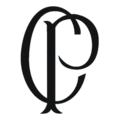 |
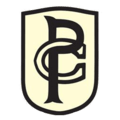 |
 |
 |
 |
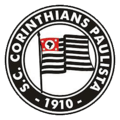 |
 |
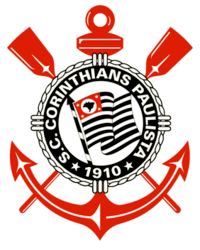 | |
Kit sponsorship and manufacturers
Previous main sponsors have been: Bombril (1982), Cofap (1983), Citizen (1984), Bic (1984), Corona (1984), Kalunga (1985-1994), Suvinil (1995-1996), Banco Excel (1996-1998), Embratel (1998), Batavo (1999-2000, 2009), Pepsi (2000-2004), Samsung (2005-2007), Medial Saúde (2008), Hypermarcas (2009-2012), Iveco (2012) and Caixa (2012-2017).
Nike is the manufacturer of the club's kit since 2003. Previous manufacturers have been: Topper (1980-1989, 1999-2002), Finta (1990-1994) and Penalty (1995-1998).
Facilities
Stadiums
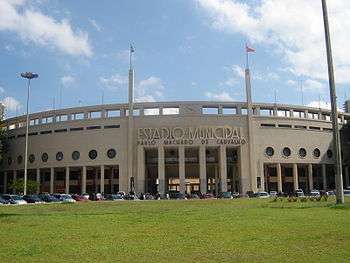
Former Stadiums
- Campo do Lenheiro & Estadio do Bom Retiro:
The first field of the Corinthians was in the neighborhood of Bom Retiro, where the club was founded in 1910. More precisely in the old street of Immigrants, current Rua José Paulino. It was actually a stadium, but a vacant lot owned by a seller of firewood.[26] It was nicknamed "Field Lenheiro." [27] It was the time of the floodplain and the players themselves had to clean and flatten the lawn.[26]
- Ponte Grande:
In January 1918, Corinthians opened its first stadium, in Great Bridge (now the Bridge of Flags), on the banks of Tiete River.[26] The land was leased from the municipality under the influence of the intellectual Antonio de Alcantara Machado, one of the first to approach the club workers. Stood beside the Chácara da Floresta, AA das Palmeiras (one of the largest clubs in the city so far)'s stadium and was built by the players and fans in a community helping system.[26] The Corinthians played their games there until 1927. They played 138 games with 83 wins, 43 draws and 12 defeats.[28]
- Parque São Jorge:
In 1926, the club purchased Parque São Jorge, located within the Tatuapé. The Parque São Jorge belonged to Esporte Clube Sírio, a rival in the disputes of the football season. After purchase, then-President Ernesto Cassano decided to reform the stage, with financial support from the members.[29] While the reforms were carried out, followed the Corinthians sending their matches in the area of Great Bridge. Once stopped reforms in the Parque São Jorge, in 1928, the field of Ponte Grande was donated to São Bento (no relation to present-day Esporte Clube São Bento).[29] The renovated Parque São Jorge, still without floodlights, was inaugurated on July 22, in a friendly game against América-RJ.[30] The land purchased with the original included a Syrian farm - hence the nickname "Fazendinha", still used today. It was from here that the Corinthians began to develop and could build up its headquarters.[29]
In Estádio Alfredo Schürig, the official name of "Fazendinha", the club only played in 468 deals, with 346 wins, 60 draws and 62 defeats. 1312 goals were scored by Timão and 480 conceded. The last game played there was a friendly against Brasiliense on August 3, 2002.[30] Currently, the Parque São Jorge is used for training and games of smaller categories. The board has the idea of reforming it, but the plans never leave paper.[29]
- Pacaembu
With the growing number of fans, Corinthians began operating in major stadiums, in particular, the club has established a relationship with Paulo Machado de Carvalho Stadium, which belongs to the municipality of São Paulo and is best known as Pacaembu Stadium.[31] Some 50,000 fans attended the inauguration of the stadium on April 28 of 1940. The primary pitted Palestra Italia and Coritiba. Then, the game between Corinthians background, then current three-time champion São Paulo, and Atlético Mineiro, Corinthians won by 4–2.[31]
The Pacaembu was opened as the largest stadium in the Latin America, with capacity for 70,000 people.[31] In 1942, little more than 70,000 people came to the stadium to watch the match between Corinthians and São Paulo, in particular by the attacker Leonidas da Silva, idol-Pauline and are considered the best Brazilian player in his time.[32] The game ended tied at 3–3 and the public was never beaten that game at the stadium. Currently, the Pacaembu has capacity for up to 40,000 spectators.[33]
Former partner group HTMF bought land in the Raposo Tavares Highway in the late 1990s for the stadium construction, but the partnership ended soon after that.
Arena Corinthians
In 2009 there were some conjectures that the government of São Paulo could make a deal for a 30-year allotment of Pacaembu, but it never materialized, even though it was the club's directors preference, with projects designed to that matter.
After Estádio do Morumbi, then named as the city's host in the World Cup, failed to comply to FIFA's standards, a new project to create a home for Corinthians emerged as a possibility. In August 2010 the president of CBF, Ricardo Teixeira, along with Governor of São Paulo state, Alberto Goldman, and the mayor of São Paulo, Gilberto Kassab announced that the opening ceremony of the World Cup of Brazil would be held in the New Corinthians Stadium to be built in the district of Itaquera, in the eastern part of São Paulo city.[34][35]
Training facility
CT Joaquim Grava
- Hotel:
There are 32 Bedrooms in Hotel CT Joaquim Grava; 2 players per room during Pre-Season, 1 to a room while in Season. The auditorium in the hotel allows for Lectures & Team meetings. The hotel restaurant seats 60. The hotel is complete with physiotherapy and massage rooms ; offices for the president and the Board of directors, offices for hotel administration, a Locker Room for the visiting team, games rooms, an internet café and a reading room.
- Annex:
Office of Technology & Statistics; Office of the Logistics Supervisor; a Large shared Multi-Purpose office for Security, Communications & TV Corinthians, & Administrative meeting room
- Laboratório Corinthians-R9:[36]
an in-house bio-mechanics complex for the main purpose of injury prevention. Machines measure the contact force and velocity of the joints in running, jumping and kicking. Also measured, The force & reaction timing of players during acceleration and deceleration, as well as analysis of how their effort may adversely affects their joints and muscles.
- CePROO:[37]
or Centro de Preparação e Reabilitação Osmar da Oliveira (Center for Preparation & Rehabilitation). Gym, physical therapy rooms, heated pools and locker rooms.
- Press Room:
Seats over 100 Media Officials
- Team Chapel:
For individual Prayer
- External Space:
Mini-gym, Courts with approval of FIBA (basketball) and FIVB (volleyball) for official games, outdoor pool, BBQ, & a tennis court.
Club culture
Supporters
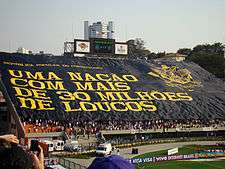
The Corinthians fanbase is fondly called Fiel ("The Faithful"), starring memorable moments like the "Corinthian Invasion" (pt / Invasão Corinthiana) in 1976, when more than 70,000 Corinthians Fans traveled from São Paulo to Rio de Janeiro to watch the match against Fluminense at Maracana Stadium, in that year's national championship semifinals, as well as having one of the biggest average attendances in the country. Fans being famous for being passionate about the team and loyal supporters motivated the club to make a tribute documentary to their fans, named "Faithful" (pt / Fiel), highlighting the fans' support in one of the most difficult moments in the club's history: the relegation to national second division in 2007. Similar initiatives would be made in the next years, reflecting other moments in the club's history in that the fanbase was essential.
Fan organizations
- Gaviões da Fiel[38] (Hawks of the Faithful)
Motto: "Lealdade, Humildade e Procedimento" (Loyalty, Humility & Procedure)
Gaviões da Fiel was founded on 1 July 1969, but its ideology began to be thought of before. In 1965, young Corinthians fans gathered in the stands in order to question the political and administrative life of the Corinthians. The members gathered in different locations, members homes, workplaces, & public squares. This group was distinguished by a passion for the club and have characteristics idealizing and fulfilling. The foundation of Gaviões, on 1 July 1969, came during a bleak time for Brazilians, amidst the military dictatorship. At a time when freedom of expression was virtually nonexistent, these young fans began to attempt recover political and administrative control of Corinthians. The Corinthians were under the administration of Wadih Helu, who for years tried to prevent the creation of the Gaviões through several reprisals. This persecution was not enough to make them give up and gradually his ideas were maturing. "I had decided that the name of the club should contain faithful, as well as the fans were already known to the Corinthians that even after 15 years without winning a single title, crowds took to the stage." What was simply an utopia of young lovers and revolutionary thoughts turned into reality: Gaviões da Fiel was born.
Currently, Gaviões has 97,177 members (January 14, 2013), The largest organized fan organization in Brazil.[39]
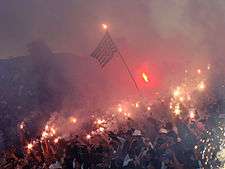
- Camisa 12[40] (The 12th Shirt)
Motto: "O Jogador das arquibancadas" (The player of the terraces)
Camisa 12 was founded in August 1971, the non-politicized offshoot of Gaviões da Fiel.
The greatest moment for the torcida came in 1976, during "Invasão Corintiana", in a memorable semi-final against Fluminense, Camisa 12 actively participated. When Over 70,000 Corinthians fans from São Paulo made the 280 mile trip to Rio de Janeiro's Maracana Stadium with scores of Flags, Banners, & Percussion Ensembles. The attendance for that match was 147,000+.[41]
- Pavilhão Nove[42] (The Pavilion Nine)
Motto: "Preso por uma só Paixão" (Incarcerated by a single passion)
It was founded on September 9, 1990 by nine Timão fans in honor of the team Football Carandiru House of Detention. The symbol adopted was from the Disney Cartoon DuckTales of its antagonists The Beagle Boys. The torcida grew out of a social program carried out in Carandiru Penitentiary, once the largest prison in Latin American (Now Demolished) & site of the Carandiru Massacre. Where a group of friends, young fans of Corinthians, formed a team and promoting a charity football match against a team of Carandiru detainees, mainly composed of Corinthians supporters, all from the ninth pavilion of the institution, hence its name. This group, through raffles, promotions and sports culture contributions, began to raise funds for the making banners and flags to divulge the its philosophy on games in the stadiums of the Corinthians. The idea of creating an organized torcida was and to mature on September 9, 1990 officially became a Corinthians Organized Torcida, christened The Pavilion Nine.[43]
- Estopim da Fiel[44] (The Faithful's Fuse)
Motto: "Raça e Atitude" (Bravery & Demeanor)
- Fiel Macabra[45] (Macabre Faithful)
Motto: "A Mais Fanática do Interior" (The Most Fanatical in the Interior)
Fiel Macabra, Founded on October 4, 1993 in Bauru, SP. This torcida was founded by a group of friends that regularly met in Bauru cafeteria. After its initial 3 years, it opened an official headquarter in Bauru, with 5 other offices following soon at the interior of São Paulo. With about 1,800 Members, it is the team's largest ultras in the interior of São Paulo.
- Coringão Chopp[46] (Draught Beer Corinthians)
Motto: "Torcer e Beber pelo Corinthians" (Drink & Root for Corinthians)
Coringão Chopp, Founded on October 14, 1989. This torcida's origins begin in the 1980s on a Greater São Paulo courtyard. The local was frequented by a group of friends who met casually to play street football & drink beers together after Corinthians games. In 1989, These friends decided frequent Corinthians matches as a unit, They began by going in separate cars. That year their group of friends grew, all them from Greater São Paulo, mainly The ABC Region & their courtyard became a "Meeting Point" for the masses of new friends. That same year, the owner of the courtyard known as Dinho was discussing the sheer volume of Corinthians Fans that considered his courtyard as a Pre-match meeting point. It was that moment when Dinho & friends realized that they had the numbers to create an organized torcida. The members of the newly created torcida, reached a simple agreement on what to name themselves. They agreed that they both had a passion for Corinthians & Chopp (Draught beer). After years of growth in membership, respect, & acceptance, the torcida moved out of the Courtyard & set up a headquarters in Diadema.[47]
- Regional
Many of the Torcidas above have Sub-sedes (Branch Offices) established by fans living outside of São Paulo. Gavioes in particular has 10, 8 In-State, 1 Out-of-State Brasilia, & 1 International Japan. Camisa 12 with 8, 6 In-State, 2 Out-of-State Minas Gerais & Espírito Santo. Pavilhão Nove with 10, 9 In-State, 1 Out-of-State Mato Grosso do Sul. Estopim da Fiel with 10, 8 In-State, 2 Out-of-State Parana & Minas Gerais. Fiel Macabra with 6, 5 In-State, 1 Out-of-State Rio Grande do Sul. Coringão Chopp with 5, all in-state.
Symbols
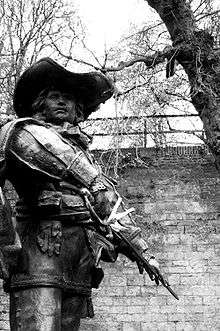
- Musketeer:
Corinthians' official mascot is the Musketeer, a symbol of bravery, audacity and fighting spirit. The adoption of that character recalls the first years of the club.
In 1913 most of the leading football clubs in São Paulo State founded the APEA (Paulista Athletic Sports Association). The depleted Paulista League was left with only Americano, Germania and Internacional, known as the "three musketeers" of São Paulo football. Corinthians joined the three as D'Artagnan, being the fourth and most adored musketeer, just like in Alexandre Dumas, père's novel The Three Musketeers. To be accepted in that "musketeers universe",
Corinthians had to show their bravery. As there was many other teams who coveted the spot in the Liga Paulista, Corinthians participated in a selective tournament against Minas Gerais and São Paulo, two other great teams of Paulista amateur football at that time. The Corinthian team beat Minas 1–0 and São Paulo 4–0, earning acceptance into the group and acquiring the right to participate in the Special Division of the Paulista League in the following year.
- Saint George:
An important symbol for Corinthians is Saint George/(Ogum). Saint George is one of the most revered Catholic Saints in Brazil, a nation with a blend of cultures. The collusion between African & European cultures is seen in Brazil's definition of São Jorge as a mash between Catholicism & Western African Mythology. The comparison may be drawn the entities similar characteristics; St George, the soldier who protects those who pray to him; Ogum God of War who serves the communities who believe in him. it is this warrior demeanor that made Corinthians fans indebted to São Jorge.
Corinthians began as a small team for the lower classes of São Paulo, even though they obtained initial success. Lack of respect for the working class by forced Corinthians to leave their São Paulo State Football League in protest. after multiple championships Timão made its largest leap in prestige in the founding of a Corinthians' Headquarters, 1926. The creation of said headquarters became the first fusion of Timão & São Jorge. The land purchased for the headquarters was formerly Parque São Jorge (St. George Park) at 777 Rua São Jorge, Tatuapé, São Paulo, SP.[48]
Corinthians support for São Jorge became fanatical during the decade of the 60's, Between 1954 and 1977, Corinthians failed to add to its gallery of conquests and the Corinthian Nation lived the hardest moments of its history. While the stream struggled in the 60's, fan recanted that they were blessed by a "Santo Guerreiro" (Warrior Saint). In the early 60's the lack of success lingered in the minds of fans & gave birth to a utilization of the blessings of São Jorge. this caused Corinthians to erect a chapel in honor of the saint, in order to strengthen the clubs resolve via mysticism. 1969, after the death of two players Lidu & Eduardo, the funeral was held in Capela São Jorge, & strengthened the clubs identity at a time when championships were non-existent. 1974 Paulista Final, after a heart-wrenching loss to arch-rival Palmeiras, composer Paulinho Nogueira recorded "Oh Corinthians", a song that had popular commercial success at the time. In the verses of the composition dedicated to the suffering Corinthians could not miss the quote to the patron Saint George:
"...Oh, são 20 anos de espera. Mas meu São Jorge me dê forças, para poder um dia enfim, descontar meu sofrimento em quem riu de mim".
("... Oh, It's been 20 years of waiting, but my St. George gives me strength to be able to one day finally cashing in my suffering upon those who laughed at me.)"
Corinthians 2011 third kit, was burgundy colored & featured São Jorge slaughtering a dragon in a dark watermark across the right side of the chest. The utilization of São Jorge's image on the shirt is the practice of São Jorge's Prayer.
Rivalries
Derby Paulista

Derby Paulista is a crosstown fixture between Corinthians and Palmeiras, consistently cited as one of the greatest rivalries worldwide by sources including FIFA,[49] CNN,[50] and the Daily Mail.[51] Palmeiras was founded by a group of Italians who were formerly members of Corinthians.[52] Since 1914, when that treasonous act was taken upon these former supporters, a deep-seated hatred was born.[52] The Derby atmosphere is fierce on and off the pitch, as violence is a norm between the clubs.[53]
Clássico Majestoso
Clássico Majestoso is a crosstown fixture between Corinthians and São Paulo. The Derby dates back to 1935, at the final re-founding São Paulo after being thrice defunct. Corinthians possesses the largest number of supporters in the state (25 Million), whereas São Paulo's lies in second place (16 Million). The Clássico's most memorable match for Corinthians is the 1990 Campenato Brasileiro finals, which led to Corinthians first national title.
Clássico Alvinegro
Clássico Alvinegro is a regional fixture between Corinthians and Santos.'Alvinegro' is given after the colors worn by both teams, black and white (Alvi, from Latin albus, white, and negro, black). The Classico reached one of its highest stages for Corinthians supporters when Corinthians met Santos in the Semi-Finals of Libertadores 2012. Corinthians won 2-1 on aggregate.
Other Rivalries
Derby dos Invictos (Derby of the Undefeated), Corinthians and Portuguesa is a crosstown rivalry. Corinthians vs Ponte Preta is an in-state rivalry that peaked in the 1977 Campeonato Paulista final, which led to Ponte Preta's greatest Paulista Finish (runner-up). Classico das Multidões (Classic of The Masses) is an inter-state rivalry pegging the two most supported teams in Brazil: Corinthians and Flamengo. Corinthians and Vasco led to great match ups and some rivalry recently, mostly after Vasco winning the Brasileirão in 1997 and 2000, and Corinthians in 1998 and 1999. Their greatest match coincided with the first FIFA Club World Cup in 2000, with a Corinthians victory in the penalty shootout. Corinthians also won the 2011 Brasileirão in the last round of the season, two points over the runners-up Vasco. Corinthians saved Vasco from their usual runner-up fate by defeating the cariocas in 2012 Libertadores Quarter-finals.
Players
As of 22 August 2018
Note: Flags indicate national team as defined under FIFA eligibility rules. Players may hold more than one non-FIFA nationality.
|
|
Out on loan
Note: Flags indicate national team as defined under FIFA eligibility rules. Players may hold more than one non-FIFA nationality.
Notable Former Players
- For all Corinthians players with a Wikipedia article see:Category:Sport Club Corinthians Paulista players.
Technical staff
Current technical staff
As of September 6, 2018.:[54]
- Manager - Jair Ventura
- Assistant Managers - Osmar Loss, Fabinho, Dyego Coelho, Emílio Faro
- Technical Supervisor - André Dias
- Head Scout - Alysson Marins
- Fitness coach - Anselmo Sbragia
- Assistant Fitness Coaches - Shih Chien Chan Junior, Fabricio Ramos do Prado, Flávio Furlan, Leandro Serafim da Silva
- Goalkeeping Coach - Leandro Idalino
- Medical Consultant - Joaquim Grava
| Board of Directors | |||
|---|---|---|---|
| Name | Position | ||
| Andrés Sánchez | President | ||
| Edna Murad Hadlik | Vice-President | ||
| Alexandre Husni | Vice-President | ||
| Duilio Monteiro Alves | Football Director | ||
| Alessandro Mori Nunes | Football Manager | ||
| Matias Antônio Romano de Ávila | Financial Director | ||
| Luis Paulo Rosenberg | Marketing Director | ||
Notable managers
List criteria:
- Manager has directed over 100 matches for the club, or
- Manager has won consecutive Campeonato Paulista's, or
- Manager has won a Copa do Brasil, or Campeonato Brasileiro Série A, or Copa Libertadores, or FIFA Club World Cup
| Name | Years | G | W | D | L | GF | GA\ | W% | CP-A1 | CB | CB-A | CL | CWC | Notes |
| 1915–20 1935 1937 |
192 | 135 | 18 | 39 | 0 | 0 | 70.31 | 1915 1937 |
[55] | |||||
| 1921–25 | 117 | 88 | 11 | 18 | 321 | 112 | 75.21 | 1922 1923 1924 |
[56] | |||||
| 1927 1937–38 |
66 | 29 | 15 | 22 | 135 | 113 | 43.94 | 1937 1938 |
[57] | |||||
| 1929–31 | 84 | 51 | 17 | 16 | 284 | 142 | 60.71 | 1929 1930 |
[58] | |||||
| 1939–42 1947–49 1963 |
215 | 143 | 31 | 41 | 0 | 0 | 66.51 | 1939 1941 |
[59] | |||||
| 1942–43 1951–54 1958–59 1963 1969 |
255 | 161 | 43 | 51 | 0 | 0 | 63.14 | 1951 1952 |
1953 1954 |
[60] | ||||
| 1954–57 1964–66 1969 1977–78 1980–81 |
438 | 249 | 96 | 93 | 0 | 0 | 56.85 | 1954 1977 |
[61] | |||||
| 1959–60 1974–75 |
124 | 67 | 26 | 31 | 158 | 209 | 54.03 | [62] | ||||||
| 1969–70 1975 |
122 | 54 | 39 | 29 | 187 | 116 | 44.26 | [63] | ||||||
| 1972 1976–77 |
113 | 54 | 36 | 23 | 113 | 88 | 47.79 | 1977 | [64] | |||||
| 1978–79 | 107 | 48 | 41 | 18 | 150 | 96 | 44.86 | 1979 | [65] | |||||
| 1981–82 1985 |
122 | [66] | ||||||||||||
| 1985 1987 1989–90 1992 |
116 | 51 | 42 | 23 | 140 | 90 | 43.97 | [67] | ||||||
| 1990–91 1992–93 1997 2007 |
192 | 84 | 66 | 42 | 277 | 203 | 43.75 | 1997 | 1990 | [68] | ||||
| 1995–96 | 110 | 52 | 29 | 29 | 185 | 130 | 47.27 | 1995 | [69] | |||||
| 1998 2001 |
139 | 65 | 34 | 40 | 258 | 180 | 46.76 | 2001 | 1998 | [70] | ||||
| 1999–00 2004 2016 |
121 | 60 | 25 | 36 | 231 | 173 | 49.59 | 1999 | 1999 | 2000 | [71] | |||
| 2004–05 2010–13 2015–16 |
378 | 196 | 110 | 72 | 536 | 283 | 51.85 | 2013 | 2011 2015 |
2012 | 2012 | [72] | ||
| 2008–10 2014 |
250 | 138 | 64 | 48 | 407 | 236 | 55.20 | 2009 | 2009 | [72] | ||||
| 2017–18 | 114 | 59 | 32 | 23 | 150 | 85 | 51.75 | 2017 2018 |
2017 | [72] |
Presidents
| Name | Tenure |
|---|---|
| 1910 | |
| 1910–14 | |
| 1915 | |
| 1915–16 | |
| 1917 | |
| 1918 | |
| 1919 | |
| 1920–25, 1927 | |
| 1925 | |
| 1926, 1928 | |
| 1929 | |
| 1929–30 | |
| 1930–33 | |
| 1933 | |
| 1933–34 | |
| 1935–41 | |
| 1941 | |
| 1941 | |
| 1941–43 | |
| 1944–46 | |
| 1947–48 | |
| 1948–59 | |
| 1959–61 | |
| 1961–71 | |
| 1971–72 | |
| 1972–81 | |
| 1982–85 | |
| 1985–87 | |
| 1987–91 | |
| 1991–93 | |
| 1993–07 | |
| 2007 | |
| 2007–11 | |
| 2012–15 | |
| 2015–18 | |
| 2018– |
Statistics
Recent seasons
| Last Ten Seasons | |||||||||||||||||
| Year | Campeonato Brasileiro | Copa do Brasil | Continental/Worldwide | Campeonato Paulista | |||||||||||||
|---|---|---|---|---|---|---|---|---|---|---|---|---|---|---|---|---|---|
| — | Div | Pos | G | W | D | L | GF | GA | Fase Máxima | Competition | Fase Máxima | Div. | Fase Máxima | Pos. | |||
| 2008 | B | 1º | 38 | 25 | 10 | 3 | 79 | 29 | Final | — | — | A1 | First stage | 5º | |||
| 2009 | A | 10º | 38 | 14 | 10 | 14 | 50 | 54 | Final | — | — | A1 | Final | 1º | |||
| 2010 | A | 3º | 38 | 19 | 11 | 8 | 65 | 41 | — | CL | Round of 16 | A1 | First stage | 5º | |||
| 2011 | A | 1º | 38 | 21 | 8 | 9 | 53 | 36 | — | CL | First stage | A1 | Final | 2º | |||
| 2012 | A | 6º | 38 | 15 | 12 | 11 | 51 | 39 | — | CL | WC | Final | Final | A1 | Quarter-finals | 5º | |
| 2013 | A | 10º | 38 | 11 | 17 | 10 | 27 | 22 | Quarter-finals | CL | RS | Round of 16 | Final | A1 | Final | 1º | |
| 2014 | A | 4º | 38 | 19 | 12 | 7 | 49 | 31 | Quarter-finals | — | — | A1 | First stage | 9º | |||
| 2015 | A | 1º | 38 | 24 | 9 | 5 | 71 | 31 | Round of 16 | CL | Round of 16 | A1 | Semi-finals | 3º | |||
| 2016 | A | 7º | 38 | 15 | 10 | 13 | 48 | 42 | Quarter-finals | CL | Round of 16 | A1 | Semi-finals | 3º | |||
| 2017 | A | 1º | 38 | 21 | 9 | 8 | 50 | 30 | Fourth Round | SA | Round of 16 | A1 | Final | 1º | |||
|
|
Honours
International competitions
- Winners (1): 2012
- Winners (1): 2013
Domestic competitions
- Winners (1): 1991
- Winners (1): 2008
Regionals
- Winners (29): 1914, 1916, 1922, 1923, 1924, 1928, 1929, 1930, 1937, 1938, 1939, 1941, 1951, 1952, 1954, 1977, 1979, 1982, 1983, 1988, 1995, 1997, 1999, 2001, 2003, 2009, 2013, 2017, 2018
- Winners (5): 1950, 1953, 1954, 1966, 2002
Other titles
- Winners (1): 1956
- Winners (1): 1953
Notes
References
- ↑ "Los 50 equipos más valiosos de América". Forbes Mexico. Retrieved October 3, 2017.
- ↑ Ad Age Million Soccer Fans Sang Brand Jingles to Raise Money for This Brazilian Club https://www.creativity-online.com/work/corinthians-30-million-sponsors/46883title=30 Million Soccer Fans Sang Brand Jingles to Raise Money for This Brazilian Club Check
|url=value (help). Retrieved November 3, 2017. Missing or empty|title=(help) - ↑ not to be confused with São Paulo Futebol Clube
- ↑ do not confuse with Sociedade Esportiva Palmeiras
- 1 2 "No Bom Retiro, em 1910, Começa Esta História". Folha de S.Paulo (in Portuguese). May 12, 1976. Retrieved August 8, 2012.
- ↑ BORBA, Marco Aurélio (November 5, 1982) "O Timão cheio de bossas". Revista Placar. pp. 50-53
- ↑ Campeonato Brasileiro Série A 1990 at RSSSF Archived May 2, 2006, at the Wayback Machine.
- ↑ Supercopa do Brasil at RSSSF Archived November 15, 2005, at the Wayback Machine.
- ↑ Copa do Brasil 1995 at RSSSF Archived June 14, 2008, at the Wayback Machine.
- 1 2 Campeonato Paulista at RSSSF Archived April 17, 2008, at the Wayback Machine.
- ↑ Campeonato Brasileiro Série A at RSSSF Archived January 28, 2006, at the Wayback Machine.
- ↑ "2000 FIFA Club World Cup at RSSSSF". Rsssf.com. Retrieved July 31, 2012.
- ↑ Copa do Brasil 2002 at RSSSF Archived May 3, 2006, at the Wayback Machine.
- ↑ "football news | Corinthians break with MSI". Eyefootball.com. July 26, 2007. Retrieved March 19, 2012.
- ↑ Brazilian Ronaldo set to join Corinthians – The Telegraph, December 9, 2008
- ↑ Ronaldo agrees to join Corinthians – The Independent, December 9, 2008
- ↑ "World Football – Adriano signs for Corinthians – Yahoo! Eurosport". Uk.eurosport.yahoo.com. Retrieved March 19, 2012.
- ↑ "World Football – Adriano signs for Corinthians – Yahoo! Eurosport". ESPN Soccernet. July 4, 2012. Retrieved July 5, 2012.
- ↑ "Corinthians, the cream of South America". FIFA.com. July 5, 2012. Retrieved July 10, 2012.
- ↑ "Estudo: Corinthians é primeiro brasileiro com marca superior a R$ 1 bi". Esportes.terra.com.br. July 16, 2012. Archived from the original on October 17, 2015. Retrieved July 31, 2012.
- ↑ "World is lost for Chelsea". ESPNFC.Com. December 16, 2012. Retrieved December 18, 2012.
- ↑ McCourt, Ian (December 16, 2012). "Chelsea v Corinthians – as it happened". Guardian UK. London. Retrieved December 17, 2012.
- ↑ "Corinthians 1 Chelsea 0". BBC Sport. December 16, 2012. Retrieved December 17, 2012.
- 1 2 1913: Nasce o Mosqueteiro corintiano Archived June 2, 2010, at the Wayback Machine. - Lance1, May 28, 2010
- ↑ 1914 - O primeiro título e o primeiro ídolo Archived May 2, 2013, at the Wayback Machine. - Lance!, May 29, 2010
- 1 2 3 4 1918: Corinthians teve seu primeiro estádio Archived June 15, 2013, at the Wayback Machine. - Lance!, June 2, 2010
- ↑ Pelé.net. "Destaques da história do Corinthians". Retrieved February 6, 2009.
- ↑ Corinthians 5000 Jogos: Clube Archived June 8, 2008, at the Wayback Machine. - Lance!, February 17, 2008
- 1 2 3 4 1926: Timão compra o Parque São Jorge Archived May 2, 2013, at the Wayback Machine. - Lance!, June 10, 2010
- 1 2 1928: Satanás, ídolo e muralha corintiana Archived May 2, 2013, at the Wayback Machine. - Lance!, June 12, 2010
- 1 2 3 1940: A primeira partida do Corinthians no Pacaembu Archived May 2, 2013, at the Wayback Machine. - Lance!, June 24, 2010
- ↑ 1942: Corinthians conquista o Torneio Quinela de Ouro Archived May 2, 2013, at the Wayback Machine. - Lance!, June 26, 2010
- ↑ "Federação Paulista de Futebol,". Site Oficial. Retrieved December 21, 2009.
- ↑ "Novo estádio do Corinthians receberá jogos da Copa de 2014" (in Portuguese).
- ↑ "Governo de SP e CBF confirmam projeto de estádio do Corinthians para abrir Copa de 2014" (in Portuguese).
- ↑ Winckler, Bruno. "Inspirado por Ronaldo, Corinthians inova em prevenção de lesões". iG. Retrieved August 5, 2012.
- ↑ ELUSTONDO, CAROLINA. "Timão investe R$ 1 milhão e mostra Ceproo". Globo Esporte. Retrieved August 5, 2012.
- ↑ "Gaviões da Fiel". Gavioes.com.br. Retrieved July 31, 2012.
- ↑ "Nasce Os Gaviões Da Fiel". Gavioes.com.br. Retrieved July 31, 2012.
- ↑ "Camisa 12". Camisa12net.com.br. Retrieved July 31, 2012.
- ↑ "Camisa 12 Historia". Camisa12net.com.br. Retrieved July 31, 2012.
- ↑ "Pavilhão Nove". Cdpavilhaonove.net. Retrieved July 31, 2012.
- ↑ "Pavilhão 9 historia". Cdpavilhaonove.net. Retrieved July 31, 2012.
- ↑ "Pavilhão 9". Estopimdafiel.com.br. Retrieved July 31, 2012.
- ↑ "Fiel Macabra". Facebook.com. Retrieved July 31, 2012.
- ↑ "Coringão Chopp". Facebook.com. Retrieved July 31, 2012.
- ↑ "Coringão Chopp historia". Coringaochopp.com.br. Retrieved July 31, 2012.
- ↑ "Sport Club Corinthians Paulista Headquarters". Google. Retrieved May 5, 2013.
- ↑ "Corinthians Vs Palmeiras, Sao Paulo's Historic Tussle". FIFA. Retrieved August 5, 2012.
- ↑ Duke, Greg (October 22, 2008). "Football First 11: Do or die derbies". CNN. Retrieved August 5, 2012.
- ↑ Fortune, Matt. "THE LIST: The greatest rivalries in club football, Nos 10-1". London: Daily Mail. Retrieved August 5, 2012.
- 1 2 Mariante, José Henrique (December 13, 1997). "História:Palmeiras nasceu de dissidência corintiana (History: Palmeiras birth out of Corinthians dissidence)". Folha de S.Paulo (in Portuguese). Retrieved August 8, 2012.
- ↑ "Football fan shot dead during violent clashes between rival supporters in Brazil". London: Daily Mail. March 26, 2012. Retrieved August 8, 2012.
- ↑ "Archived copy". Archived from the original on August 27, 2015. Retrieved September 1, 2015.
- ↑ "Amílcar Barbuy". Que fim levou. UOL. Retrieved August 6, 2012.
- ↑ "Guido Giacominelli". acervo sccp. Retrieved August 9, 2012.
- ↑ "Neco". acervo sccp. Retrieved August 9, 2012.
- ↑ "Virgílio Montarini". acervo sccp. Retrieved August 9, 2012.
- ↑ "Del Debbio". Que fim levou?. UOL. Retrieved August 6, 2012.
- ↑ "Rato". Que Fim Levou?. UOL. Retrieved August 6, 2012.
- ↑ "Oswaldo Brandão". Que Fim Levou?. UOL. Retrieved August 6, 2012.
- ↑ "Sylvio Pirillo". acervo sccp. Retrieved August 9, 2012.
- ↑ "dino sani". acervo sccp. Retrieved August 9, 2012.
- ↑ "Duque". acervo sccp. Retrieved August 9, 2012.
- ↑ "José Teixeira". acervo sccp. Retrieved August 9, 2012.
- ↑ "Mário Travaglini". UOL. Retrieved August 10, 2012.
- ↑ "basilio". acervo sccp. Retrieved August 9, 2012.
- ↑ "Nelsinho Baptista". acervo sccp. Retrieved August 9, 2012.
- ↑ "Eduardo Amorim". acervo sccp. Retrieved August 9, 2012.
- ↑ "Vanderlei Luxemburgo". Acervo SCCP. Retrieved August 6, 2012.
- ↑ "oswaldo de oliveira". acervo sccp. Retrieved August 9, 2012.
- 1 2 3 "Treinadores que mais vezes comandaram o Corinthians". meutimao.com.br. Retrieved December 15, 2014.
External links
| Wikimedia Commons has media related to Sport Club Corinthians Paulista. |
| Look up Corinthians in Wiktionary, the free dictionary. |
- Official website (in Portuguese), (in English), (in Spanish)
- Acervo SCCP – all matches and history of Corinthians
- Committee for Preservation of Corinthians' Memories
- FIFA Home Page
- Book – Top 10 Idols
